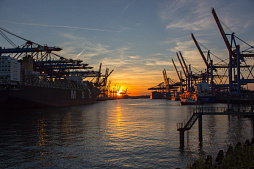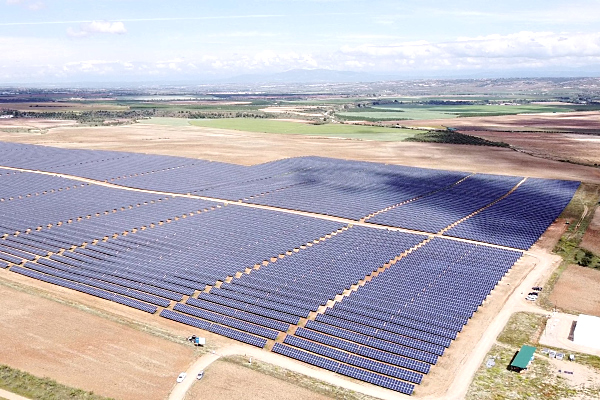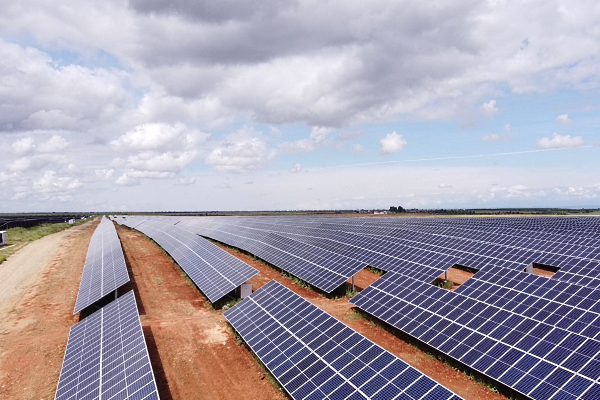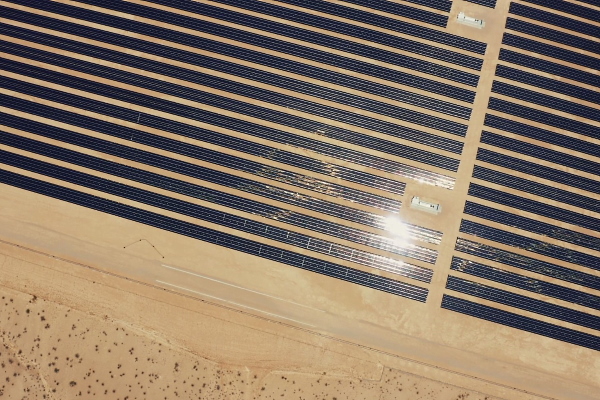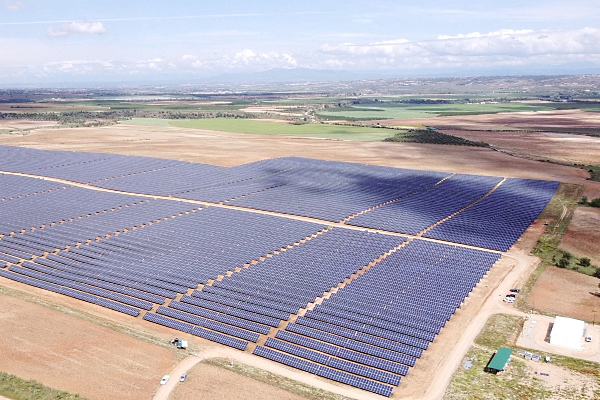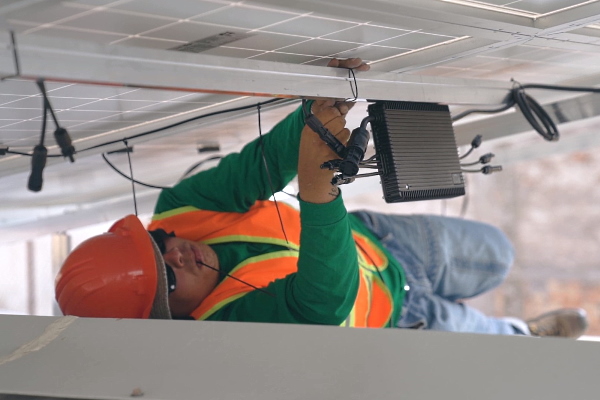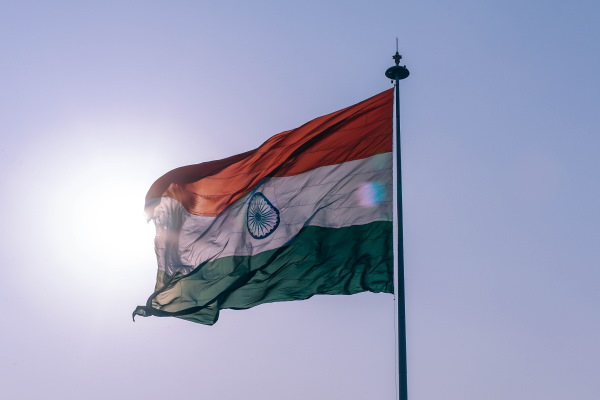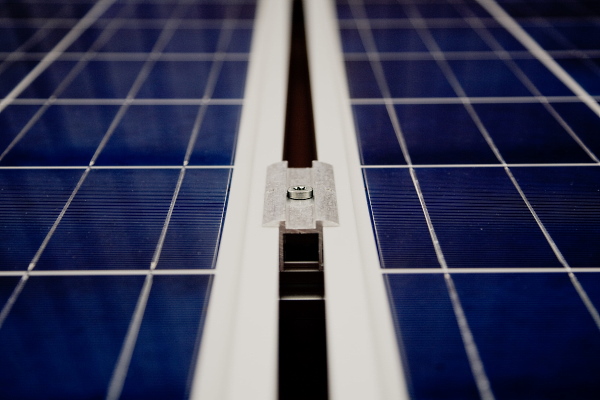To consider an application for financing, fill out the form and send it to us by e-mail along with the project brief, or contact our experts
- The current situation in the Indian energy sector
- India is building the world's largest photovoltaic power stations
- Construction of offshore solar power plants in India
- Cryogenic energy storage (CES) for the solar photovoltaic sector
- Financing the construction of photovoltaic power stations in India
- Leading solar PV equipment manufacturers and suppliers
- Solar energy market regulation in India
- The challenges of India's solar photovoltaic sector development
- Construction of photovoltaic power stations in India under an EPC contract
The construction of solar PV plants is one of the strategic priorities of the Indian government, as reflected in the Jawaharlal Nehru National Solar Mission (JNNSM).
Policy to reduce dependence on fossil fuels has spurred the growth of solar energy over the past decade.
Thanks to its unique geographic location, India is not only able to produce enough solar energy to meet its needs, but also export electricity to neighboring countries.
Solar PV power stations located in the tropics receive 3,000 hours of sunshine annually. In most of the country, photovoltaic elements are capable of producing enough energy even in cloudy weather.
Distribution of solar radiation by countries of the world:
| Country (region) | Solar radiation, kWh / m² / day | Country (region) | Solar radiation, kWh / m² / day |
| India | 5,10 | Australia | 4,16 |
| China | 3,61 | Saudi Arabia | 5,70 |
| Japan | 3,63 | Turkey | 4,45 |
| European Union | 4,68 | South Africa | 5,92 |
| Germany | 2,90 | Thailand | 4,95 |
| Italy | 3,81 | Chile | 4,62 |
| Morocco | 5,40 | Spain | 4,75 |
According to a new government plan, by 2030, 60% of the country's electricity will be generated from environmentally friendly renewable sources.
India has no plans to expand its coal-fired power plants between 2022 and 2027.
India is undoubtedly a promising solar energy market. Its attractiveness is explained by a combination of the following factors:
• Rapid economic growth.
• Large population.
• High year-round solar radiation.
• Limited access to fossil fuels.
• Lack of electricity in remote areas.
The current situation creates great opportunities for foreign investors, which are already being used by large companies from China, Japan, Germany and other countries.
The company LBFL offers financing and construction of solar power plants under an EPC contract around the world.
If you are interested in the construction of photovoltaic power stations in India under an EPC contract, contact our consultant at any time.
The current situation in the Indian energy sector
India, with a vibrant economy and a population of over 1 billion people, has always experienced energy shortages.Although the country is one of the largest electricity producers in the world, it still cannot meet the electricity needs of a growing population.
Over 70% of India's population still lives in villages, and only about half of the rural population has access to electricity.
About 75% of the country's electricity is produced from coal, which is responsible for a significant share of air pollution. According to the AirVisual report for 2018, 7 of the 10 most polluted cities on the planet are located in India. Diesel vehicle emissions, construction dust, wood burning and other factors also contribute to the problem.
According to the Institute for Health Care, in 2017, 1.2 million Indians died of diseases caused by polluted air.
Coal is also a source of carbon dioxide, which causes climate change. India is considered the third largest source of carbon dioxide on the planet, therefore the country is especially vulnerable to the effects of climate change.
It is expected that India's energy needs will double in the next decade. According to the forecast, the country's coal reserves will be completely depleted after 2050. For this reason, India is investing heavily in renewable energy, increasing the installed capacity of photovoltaic power stations.
India is the initiator of the International Solar Alliance (ISA), which includes countries located between the Tropic of Cancer and the Tropic of Capricorn. In 2018, at the Katowice Climate Conference (Poland), an agreement on cooperation in the development of solar energy was signed between ISA and the European Union.
In recent years, India has increased its installed solar power capacity from less than 4 GW in 2015 to over 30 GW. The government aims to create 175 GW of installed capacity from renewable sources by 2022. About 100 GW of them will fall on the share of solar power plants, 60 GW for wind power, 10 GW for biofuel and the remaining 5 GW for hydroelectric power (including small hydroelectric power plants).
In the first half of 2019 alone, renewable energy sources with a capacity of 7.8 GW were created in India, with a share of photovoltaic plants of about 3.5 GW.
Uneven development of the solar photovoltaic sector
If we analyze the situation in different states, Northwest India is one of the regions with the highest horizontal solar radiation.The desert and semi-desert states of Rajasthan and Gujarat are the areas with the greatest potential for the construction of photovoltaic power stations due to intense solar radiation and favorable geographic conditions.
However, desert and semi-desert areas present a number of difficulties that are not found in other parts of India. These dusty areas are prone to anthropogenic pollution and frequent sandstorms. The influence of these factors on the production of photovoltaic solar energy is significant.
According to a report from the Ministry of New and Renewable Energy, the states with the highest solar potential are Rajasthan, Jammu and Kashmir.
Although Rajasthan is at the top of the rating for installed capacity, the case of Jammu and Kashmir is surprising. Despite the huge solar potential (Leh gets 5,530 Wh / m² / day and Kargil gets 5,390 Wh / m² / day), the state is underutilizing natural opportunities due to lack of infrastructure.
At the pre-investment stage, the business should plan additional funds for the construction of roads and power lines, as well as overcoming other problems associated with the mountainous landscape.
Unlike the state of Jammu and Kashmir, the states of Telingana and Tamil Nadu, which do not have high solar potential, have managed to attract investors in recent years and become the states with the highest installed capacity.
Top 10 states in India by total installed solar capacity, 2019:
| Place | State | Installed capacity, MWt |
| 1 | Karnataka | 6095 |
| 2 | Telingana | 3592 |
| 3 | Rajasthan | 3227 |
| 4 | Andhra Pradesh | 3086 |
| 5 | Tamil Nadu | 2575 |
| 6 | Gujarat | 2440 |
| 7 | Madhya Pradesh | 1840 |
| 8 | Maharashtra | 1633 |
| 9 | Uttar Pradesh | 960 |
| 10 | Punjab | 905 |
Improving remote area power supply
In recent years, India's energy sector has increasingly relied on solar energy, one of the country's main natural resources.We are talking not only about megaprojects with a capacity of hundreds of megawatts, but also about small photovoltaic power stations for power supply of industrial enterprises and remote farms.
Much attention is paid to the efficient use of vacant areas of airports and other large facilities located near cities and already having the necessary infrastructure.
For example, in 2016, Cochin International Airport in Kerala became the world's first solar-powered airport. The 12 MW PV power plant was built on an area of 50 hectares near the cargo terminal.
The construction of the power plant, which took six months, cost the customer approximately $ 10 million.
From a technical point of view, the airport is currently independent of the external power grid, as the photovoltaic power station can generate up to 60,000 kWh of green energy per day.
Since then, similar energy projects led by Airports Authority of India (AAI) and the Solar Energy Corporation of India (SECI) have been implemented at other airports, allowing for more efficient use of vast territories. India has 136 airports, many of which cover significant areas. For example, Hyderabad International Airport covers over 5,400 hectares, and Chennai covers over 4,000 hectares.
India is building the world's largest photovoltaic power stations
In 2019, Indian energy company NTPC announced plans to build the world's largest 5 GW photovoltaic power station in Gujarat.The launch of the facility is scheduled for 2024, and the investment amount exceeds $ 3.5 billion.
This project is part of the NTPC strategy, which aims to build renewable energy sources with a total capacity of 32 GW by 2032, reducing the share of coal in its energy balance from 96% to 70%.
It is known that NTPC plans to build a hydroelectric power plant with an installed capacity of 500 MW, which will be located in Himachal Pradesh, next to another power plant of similar capacity.
The new strategy also includes the construction of another large photovoltaic power station in India. This is a project with an installed capacity of 5 GW near the city of Leh, which will be commissioned in 2023. The generated electricity will be transmitted by high-voltage power lines for almost 900 km to the city of Kaithal in Haryana state.
List of largest solar power plants in India for 2020:
| Name | Installed capacity, MW | Year of commissioning | State |
| Bhadla Solar Park | 2245 | 2020 | Rajasthan |
| Pavagada Solar Park | 2050 | 2019 | Karnataka |
| Kurnool Ultra Mega Solar Park | 1000 | 2017 | Andhra Pradesh |
| NP Kunta Ultra Mega Solar Park | 900 |
2020 |
Andhra Pradesh |
| Rewa Ultra Mega Solar Park | 750 | 2018 | Madhya Pradesh |
In 2020, Adani Green Energy, owned by billionaire Gautam Adani, won a $ 6 billion government tender to build a complex of the largest solar power plants with a total capacity of 8 GW.
The tender was announced by the state-owned SECI company, which is operated by the MNRE.
According to The Economic Times, the first 2 GW plant built by Adani Green Energy will be commissioned in 2022, and over the next three years, production will increase by 2 GW annually.
Solar power plants will be built in many parts of India.
The company says it will be one of the largest energy projects of this type in the world. Through direct investments in other sectors of the economy, the project will help create about 400 thousand jobs.
According to The Hindu, the Adani Group is now expected to build 25 GW of installed renewable generation capacity within 5 years. The company's investment in this sector will reach $ 15 billion, and this is only the beginning of the story.
Construction of offshore solar power plants in India
One of the most important trends in the development of solar energy in India is the movement of solar power plants from land to water.Hundreds of solar megawatts are being installed on rivers and reservoirs today.
Utilities and energy companies are moving their facilities to the water under unrelenting pressure from government agencies. This trend is also explained by the fact that it is increasingly difficult for companies to acquire large plots of land for the construction of photovoltaic power stations on land.
Thus, offshore solar power plants very quickly turned from an experiment into a full-fledged niche market. Greenam Energy and others are installing floating platforms in India's industrial regions, providing local businesses with reliable renewable energy sources.
Numerous local reservoirs and rivers with dams provide ideal opportunities for the construction of offshore solar power plants.
The development of this segment will help India move closer to the goal of building 100 GW of installed PV capacity by 2022, according to Bloomberg analysts.
The World Bank believes that this country, along with China and the countries of Southeast Asia, will continue to lead the global development of offshore solar energy. In this part of the world, an abundance of water resources is combined with a scarcity of rural land and a colossal need for renewable energy sources.
As reported by The Times of India in 2019, Madhya Pradesh state has planned to build the world's largest 1 GW floating solar power plant. It should be located on the Indira Sagar water reservoir in the central part of the country.
Currently, the largest floating solar PV power plant is located in Anhui, China. It has a capacity of 150 MW, which is 6.5 times less than the planned capacity of the Indian project.
The cost of the project is estimated at about $ 700 million, and the time required to prepare the facility for commissioning is only 8 months.
The project will be financed from the World Bank.
Currently, there is only one similar plant in India. It is an offshore solar power plant with an installed capacity of 100 MW in the state of Andhra Pradesh.
Cryogenic energy storage (CES) for the solar photovoltaic sector
The interest of European countries in energy storage systems is a consequence of the implementation of the 20-20-20 policy, which, in accordance with the Energy and Climate Package, assumes a gradual increase in the share of renewable sources in heat and power generation systems.According to experts, in 2050, RES should account for 57% of global energy demand, with 26% of demand coming from wind and solar energy.
Following global trends, India is also seeking to reduce its dependence on fossil fuels by setting ambitious annual goals to increase the installed capacity of photovoltaic power stations and a range of other renewable energy sources.
Replacing the traditional concept with distributed sources, characterized by uneven generation, is a huge problem for the entire power system. The only solution to stabilize the operation of the power grid is energy storage. As a result of the introduction of new energy storage technologies, it is possible to effectively separate the production and consumption processes and to work more flexibly with distributed sources.
The problem with solar energy in India is the frequent power outages caused by the weak national electricity grid.
Long power outages are common in this country, especially in remote regions.
Cryogenic energy storage (CES), based on the use of liquid air, offers unique energy storage opportunities for photovoltaic power stations in India. Cutting-edge technologies developed by the UK company Highview Power are designed to provide backup power or efficient grid balancing in the face of growing renewable energy.
The obvious advantages of cryogenic energy storage for India are its compactness and environmental friendliness. Liquid Air Energy Storages (LAES) do not require large areas and do not pollute the atmosphere with harmful substances.
Cryogenic energy storage technology deserves special attention from investors. It is completely independent of the climatic and geological limitations of the terrain, does not require sharp changes in heights, the presence of rivers or extensive construction sites.
Cryogenic energy storage systems can be fully integrated with all types of energy sources. They have a relatively simple structure and, most importantly, do not require the engineering design of individual device prototypes. The latter fact reduces the risks and investment costs of the project.
Experts believe that liquid air energy storage could revolutionize the Indian photovoltaic sector. Highview Power engineers are implementing large renewable energy storage projects in Spain, Africa and the Middle East.
Financing the construction of photovoltaic power stations in India
Currently, to meet the country's electricity demand, the government must invest heavily in renewable energy and support independent energy producers.Government aid is widely used to finance renewable energy in India.
Several commercial banks and financial institutions are involved in financing renewable energy projects.
Among them are ADB, DBS Bank, KfW DEG (Deutsche Investitions- und Entwicklungsgesellschaft), ICICI Bank, IL&FS, IFC, IDFC, IREDA, PFC, Proparco, Rabobank, SBI, Yes Bank and others.
One of the largest financial institutions in this area is IREDA (Indian Renewable Energy Development Agency Limited), which offers concessional loans for photovoltaic energy projects. In addition, the European Investment Bank and KfW (the state bank of Germany), have signed agreements with IREDA and REC (Corporation for Rural Electrification) to finance local projects.
Projects with venture capital and private equity are rather limited due to the risks associated with immature renewable energy technologies. Indian banks provide little credit for solar projects, but awareness raising and government support are gradually changing this situation.
Despite the adoption of ambitious plans such as the National Solar Mission, the lack of adequate financial support means that such initiatives may not always receive sufficient domestic funding within a given time frame.
The complexity of the procedure for applying for government subsidies and a multi-level bureaucratic system (MNRE, IREDA, SNA, State Electricity Regulatory Commission) make it difficult to implement large-scale projects. Ultimately, India needs a more flexible financial infrastructure to stimulate the production and consumption of solar photovoltaic energy.
Our company is ready to assist in financing the construction of photovoltaic power stations in India, including obtaining loans from leading European banks on optimal terms.
To learn more about investment banking services, please contact our representatives.
Estimated cost of solar power plants
To calculate the cost of building a photovoltaic power station in India, you can use the official data of the Central Electricity Regulatory Commission (CERC).Investment costs consist of the following components:
• Purchase of photovoltaic panels: the cost of Chinese PV modules has reached an all-time low, falling below $ 0.28 per 1W of installed power. At the same time, modules from Indian manufacturers remain more expensive.
• Land for construction: land value varies significantly from state to state. Areas where solar parks are built are usually deserted and of little commercial value. However, depending on the land category, formal procedures can be time consuming and costly.
• Civil engineering: the implementation of general construction work requires the involvement of a large number of low-skilled workers, the purchase or lease of construction machinery and equipment.
• Installation of PV panels: The amount of steel required to install the panels depends on the type and size of the solar park. Unfavorable weather conditions significantly increase costs.
• Purchase of inverters: With regard to inverters, equipment replacement should be considered, which takes place on average after 12-15 years of operation.
• Cables and Transformers: The construction of a solar power plant requires DC / AC transformers and cables, including wiring between panels and inverters, junction boxes, wiring between inverter and electrical substation, switches, control equipment, etc.
• Configuration: this stage requires the involvement of a highly qualified workforce.
Calculations should take into account the approximate service life of photovoltaic power stations (25 years), real productivity and auxiliary energy consumption.
The cost of projects with the same installed capacity can vary widely depending on specific conditions and customer requirements.
| Component | Cost (Rs / W) | Percentage of total cost |
| PV panels | 32,8 | 62 |
| Land plot | 2,5 | 5 |
| Civil construction | 3,5 | 7 |
| Installation work | 3,5 | 7 |
| Purchase of inverters | 3,5 | 7 |
| Cables and transformers | 4,5 | 8 |
| Assembly and configuration. | 2,7 | 5 |
| The total cost of the project | 53 | 100% |
The table above shows the cost of building photovoltaic power stations in India as of 2017.
Leading solar PV equipment manufacturers and suppliers
The government of the country is promoting the development of national production of PV panels and other solar energy equipment, which is considered a strategic industry in India.The development of domestic electrical equipment production is projected to save more than $ 40 billion in imports by 2030.
The top five local leaders in the production of photovoltaic panels in recent years were formed by such well-known Indian companies as Mundra Solar PV Limited (Adani Group), Tata Power Solar Systems Limited, Jupiter International Ltd, Moser Baer Solar Limited and Indosolar Ltd.
There are over 120 PV panel manufacturers registered in India, according to MNRE.
As competition grows, the top 5 leading manufacturers only accounted for 3,100 MW out of 8,398 MW in 2017, with the Adani Group being able to produce PV panels with a total capacity of 1,200 MW.
Foreign equipment suppliers
As for foreign manufacturers, Chinese companies dominate the Indian market.Their share in 2017 was about 70%, despite efforts to stimulate domestic production. Recent changes in subsidies policy in China have forced Chinese manufacturers to focus on foreign markets and reduce the cost of their products for Indian customers. Among the largest foreign suppliers of PV panels in India are Trina (PRC), JA Solar (PRC), Canadian Solar (Canada), Risen (PRC) and Hanwha (South Korea).
There are few foreign suppliers of inverters, but they are represented by large and reputable companies. Today, the segment has a large international presence under the clear leadership of the Swiss manufacturer ABB. The top 5 inverter suppliers are led by ABB (Switzerland), TMEIC (Japan), SMA Solar Technology (Germany), HITACHI HIREL (India) and SUNGROW (PRC).
Despite the clear dominance of foreign equipment in the market, the lion's share of EPC contracts for the engineering design and construction of solar power plants are concluded by local firms, which can more easily get access to tenders.
Solar energy market regulation in India
The Electricity Act 2013 promotes free competition in India's energy sector.The government is also seeking to reduce energy costs through competitive bidding.
Back in 2017, the Ministry of New and Renewable Energy announced a new competitive bidding procedure that facilitated the participation of international companies.
The regulation of the market and the work with tenders is carried out by the following state bodies:
• MNRE: The Ministry regulates India's renewable energy sector as a whole.
• SECI: The vast majority of solar energy tenders are published through SECI (Solar Energy Corporation of India Limited). It is the agency that carries out a significant portion of the activities of the National Solar Mission.
• NTPC: Government-owned National Thermal Power Corporation Limited specializes in power generation and also runs a number of tenders.
In addition to the central government, there are several state government departments that are responsible for permitting, supervising and conducting tenders.
The complex system of market regulation is complemented by the fact that almost any bureaucratic procedure in India is time-consuming. In each case, investors are left with concerns about the formalities of buying land or selling energy.
Implementation of solar projects in this country requires the support of qualified lawyers. Contact our representatives to find out more.
The challenges of India's solar photovoltaic sector development
Solar energy development in India is hampered not only by funding problems, but also by excessive bureaucracy, inadequate infrastructure and a shortage of skilled labor.Particularly noteworthy are the problems with the selection and purchase of land for the construction of a photovoltaic power station in India.
A power plant can only be built on commercial land if sufficient land plot can be found in the area of interest.
The problem is compounded by the slow and costly bureaucratic procedures involved in buying and leasing land. Land documents in India are drawn up in local dialects. In some cases, land title documents turn out to be incorrect or outdated.
When choosing land plots for construction, investors are faced with such problems as having several owners and crossing plots. If access to neighboring land often passes through a construction site, the company will have to solve this problem. In addition, there are special categories of land that are prohibited from buying, including tribal land, state land, as well as forest land and land allocated by the state to landless citizens.
Due to the high population density of India, there is little land available. In some cases, investors have to consider the possibility of building a floating solar power plant to implement their projects.
The technical problems with solar power plants begin with the fact that many foreign photovoltaic panels are not adapted to operate in the extreme climate of India, so they work inefficiently.
The arid conditions in the desert regions of Gujarat and Rajasthan require careful maintenance and cleaning of equipment, which increases maintenance costs. The hardness of the water makes it unsuitable for purification, which is why companies have to invest more in reverse osmosis.
Lack of skilled workforce remains a significant problem.
Although the Indian government has launched several educational programs, it is incredibly difficult to find workers with sufficient experience and knowledge in remote areas.
In this case, engineering firms tend to hire qualified employees from abroad or train local residents on their own.
According to experts, local employees tend to violate the rules of maintaining photovoltaic panels, which negatively affects the efficiency of the system and its service life.
Transmission and distribution losses due to the lack of adequate infrastructure mean that the cost of the project increases significantly. Despite efforts to establish an agency for the transmission and distribution of energy, India has a long way to go to improve its national electricity grid.
Potential difficulties for foreign investors
Despite good business prospects, India remains a challenging market.The legal framework and bureaucratic procedures are perceived by foreign investors as complex and unreliable.
Competition in the local energy sector is fierce and irrational.
In addition, most electricity consumers are very price sensitive, often at the expense of quality. Financing the construction of photovoltaic power stations is still a difficult task, as local banks are reluctant to provide business loans or do not have enough resources.
The concept of a free market was first mentioned in the Electricity Act 2003.
According to this concept, the consumer has the right to buy electricity directly from the market without burdensome agreements with distribution companies. In theory, this should make the energy market more competitive by offering the consumer a range of options without being tied to local distributors.
In practice, however, this market model does not work as the government expects. Large consumers enter the free market only when the prices offered by local distributors increase. This throws the system out of balance, hitting all suppliers. On the one hand, local distributors cannot sell purchased energy when prices rise. On the other hand, free market players have no stable demand.
Investors need to deal with the legal risks associated with Power Purchase Agreements (PPAs), given that lawsuits in this country often drag on for years. In addition, significant fluctuations in the exchange rate of the Indian rupee have deterred some international investors.
Another major barrier for foreign investors to enter the market is price regulation. In past years, prices for solar panels and inverters have changed several times, up to the reclassification of the product to another category in order to stop the import of competitive equipment from China.
Construction of photovoltaic power stations in India under an EPC contract
It is obvious that the design and construction of solar power plants is a complex multi-stage process that requires an engineering company to have a multidisciplinary team of specialists, as well as significant technological, human and financial resources.It is not profitable for most client companies to divert their resources to negotiations with numerous subcontractors, research, tendering and project management. They are interested in the optimal result, which will be achieved on time and without unexpected costs.
An EPC contract is most suitable for such companies.
EPC contracting is most often used for the construction of photovoltaic power stations in India.
The advantages of this approach for the customer are obvious. The engineering firm (contractor) offers its clients a complete turnkey project, including basic and detailed engineering design, procurement of materials and equipment, delivery to the construction site, installation and commissioning.
When signing the EPC contract, the price for the installed capacity is agreed in advance, where all costs are included.
The date of commissioning of the facility and key technological parameters are also indicated in the contract, so the client will receive exactly the power plant that he needs.
To find out the estimated cost of the project, contact our specialists and provide the required technical characteristics of the future power plant.
You can be sure to get the best technology within your budget.















